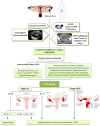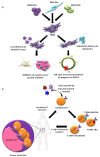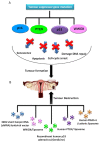Recent Progress in Gene Therapy for Ovarian Cancer
- PMID: 29966369
- PMCID: PMC6073662
- DOI: 10.3390/ijms19071930
Recent Progress in Gene Therapy for Ovarian Cancer
Abstract
Ovarian cancer is the most lethal gynecological malignancy in developed countries. This is due to the lack of specific symptoms that hinder early diagnosis and to the high relapse rate after treatment with radical surgery and chemotherapy. Hence, novel therapeutic modalities to improve clinical outcomes in ovarian malignancy are needed. Progress in gene therapy has allowed the development of several strategies against ovarian cancer. Most are focused on the design of improved vectors to enhance gene delivery on the one hand, and, on the other hand, on the development of new therapeutic tools based on the restoration or destruction of a deregulated gene, the use of suicide genes, genetic immunopotentiation, the inhibition of tumour angiogenesis, the alteration of pharmacological resistance, and oncolytic virotherapy. In the present manuscript, we review the recent advances made in gene therapy for ovarian cancer, highlighting the latest clinical trials experience, the current challenges and future perspectives.
Keywords: delivery systems; gene therapy; ovarian cancer; ovarian cancer stem cells; promoter; suicide genes.
Conflict of interest statement
The authors declare no conflict of interest.
Figures



Similar articles
-
Gene therapy for ovarian cancer.Curr Oncol Rep. 2006 Nov;8(6):441-7. doi: 10.1007/s11912-006-0073-x. Curr Oncol Rep. 2006. PMID: 17040622 Review.
-
Targeted gene therapy for ovarian cancer.Curr Gene Ther. 2005 Dec;5(6):643-53. doi: 10.2174/156652305774964668. Curr Gene Ther. 2005. PMID: 16457653 Review.
-
Advancements in adenoviral based virotherapy for ovarian cancer.Adv Drug Deliv Rev. 2009 Aug 10;61(10):836-41. doi: 10.1016/j.addr.2009.04.012. Epub 2009 May 5. Adv Drug Deliv Rev. 2009. PMID: 19422865 Review.
-
Oncolytic adenoviral gene therapy in ovarian cancer: why we are not wasting our time.Future Oncol. 2009 Apr;5(3):339-57. doi: 10.2217/fon.09.11. Future Oncol. 2009. PMID: 19374541 Review.
-
Advances in the techniques and methodologies of cancer gene therapy.Discov Med. 2019 Jan;27(146):45-55. Discov Med. 2019. PMID: 30721651 Review.
Cited by
-
Paradigm Shift: A Comprehensive Review of Ovarian Cancer Management in an Era of Advancements.Int J Mol Sci. 2024 Feb 3;25(3):1845. doi: 10.3390/ijms25031845. Int J Mol Sci. 2024. PMID: 38339123 Free PMC article. Review.
-
Lymphatic vasculature in ovarian cancer.Biochim Biophys Acta Rev Cancer. 2023 Sep;1878(5):188950. doi: 10.1016/j.bbcan.2023.188950. Epub 2023 Jul 5. Biochim Biophys Acta Rev Cancer. 2023. PMID: 37419192 Free PMC article. Review.
-
Increased temperature-related adeno-associated virus vectors transduction of ovarian cancer cells - essential signatures of AAV receptor and heat shock proteins.Exp Ther Med. 2019 Dec;18(6):4718-4732. doi: 10.3892/etm.2019.8112. Epub 2019 Oct 21. Exp Ther Med. 2019. PMID: 31772643 Free PMC article.
-
The Challenges and Prospects of p53-Based Therapies in Ovarian Cancer.Biomolecules. 2023 Jan 12;13(1):159. doi: 10.3390/biom13010159. Biomolecules. 2023. PMID: 36671544 Free PMC article. Review.
-
Molecular imaging-monitored radiofrequency hyperthermia-enhanced intratumoral herpes simplex virus-thymidine kinase gene therapy for rat orthotopic ovarian cancer.Int J Hyperthermia. 2020;37(1):101-109. doi: 10.1080/02656736.2020.1711973. Int J Hyperthermia. 2020. PMID: 31969028 Free PMC article.
References
Publication types
MeSH terms
LinkOut - more resources
Full Text Sources
Other Literature Sources
Medical

